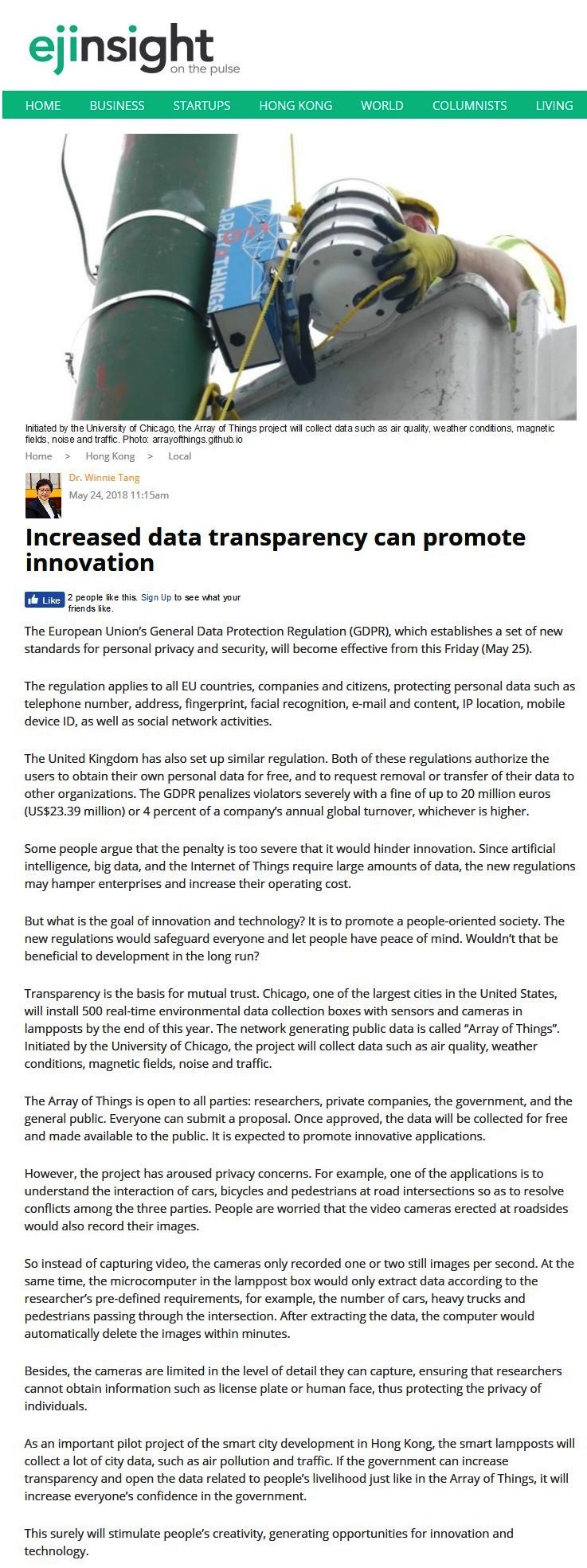網上版請按此

Increased data transparency can promote innovation
The European Union's General Data Protection Regulation (GDPR), which establishes a set of new standards for personal privacy and security, will become effective from this Friday (May 25).
The regulation applies to all EU countries, companies and citizens, protecting personal data such as telephone number, address, fingerprint, facial recognition, e-mail and content, IP location, mobile device ID, as well as social network activities.
The United Kingdom has also set up similar regulation. Both of these regulations authorize the users to obtain their own personal data for free, and to request removal or transfer of their data to other organizations. The GDPR penalizes violators severely with a fine of up to 20 million euros (US$23.39 million) or 4 percent of a company's annual global turnover, whichever is higher.
Some people argue that the penalty is too severe that it would hinder innovation. Since artificial intelligence, big data, and the Internet of Things require large amounts of data, the new regulations may hamper enterprises and increase their operating cost.
But what is the goal of innovation and technology? It is to promote a people-oriented society. The new regulations would safeguard everyone and let people have peace of mind. Wouldn't that be beneficial to development in the long run?
Transparency is the basis for mutual trust. Chicago, one of the largest cities in the United States, will install 500 real-time environmental data collection boxes with sensors and cameras in lampposts by the end of this year. The network generating public data is called "Array of Things". Initiated by the University of Chicago, the project will collect data such as air quality, weather conditions, magnetic fields, noise and traffic.
The Array of Things is open to all parties: researchers, private companies, the government, and the general public. Everyone can submit a proposal. Once approved, the data will be collected for free and made available to the public. It is expected to promote innovative applications.
However, the project has aroused privacy concerns. For example, one of the applications is to understand the interaction of cars, bicycles and pedestrians at road intersections so as to resolve conflicts among the three parties. People are worried that the video cameras erected at roadsides would also record their images.
So instead of capturing video, the cameras only recorded one or two still images per second. At the same time, the microcomputer in the lamppost box would only extract data according to the researcher's pre-defined requirements, for example, the number of cars, heavy trucks and pedestrians passing through the intersection. After extracting the data, the computer would automatically delete the images within minutes.
Besides, the cameras are limited in the level of detail they can capture, ensuring that researchers cannot obtain information such as license plate or human face, thus protecting the privacy of individuals.
As an important pilot project of the smart city development in Hong Kong, the smart lampposts will collect a lot of city data, such as air pollution and traffic. If the government can increase transparency and open the data related to people's livelihood just like in the Array of Things, it will increase everyone's confidence in the government.
This surely will stimulate people's creativity, generating opportunities for innovation and technology.
Dr. Winnie Tang
Honorary Professor, Department of Computer Science, The University of Hong Kong